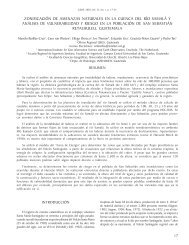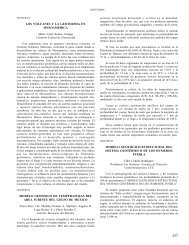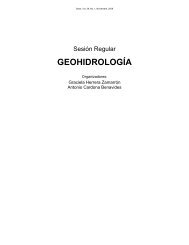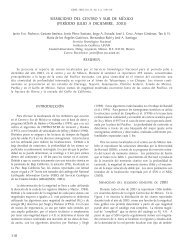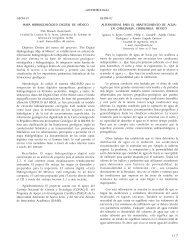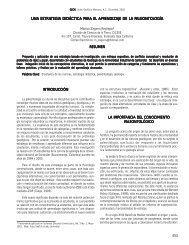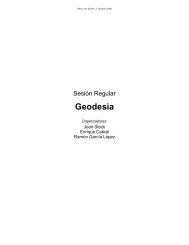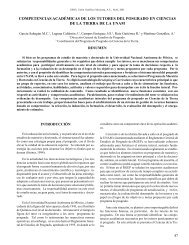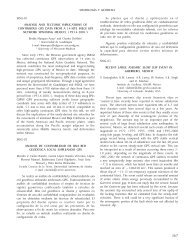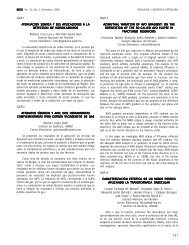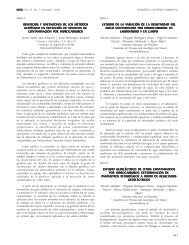Libro de Resúmenes - Unión Geofisica Mexicana AC
Libro de Resúmenes - Unión Geofisica Mexicana AC
Libro de Resúmenes - Unión Geofisica Mexicana AC
You also want an ePaper? Increase the reach of your titles
YUMPU automatically turns print PDFs into web optimized ePapers that Google loves.
Geos, Vol. 30, No. 1, Noviembre, 2010<br />
SISMOLOGÍA<br />
SIS-5<br />
SEISMIC VELOCITY DEPENDENCY ON CRUSTAL EFFECTIVE<br />
STRESSES DURING THE 2006 SLOW SLIP EVENT, MEXICO<br />
Cruz Atienza Víctor M. 1 , Rivet Diane 2 , Kostoglodov<br />
Vladimir 1 , Campillo Michel 2 y Shapiro Nikolai 3<br />
1 Instituto <strong>de</strong> Geofísica, UNAM<br />
2 Laboratoire <strong>de</strong> Géophysique Interne et<br />
Tectonophysique, Université Joseph Fourier, France<br />
3 Laboratoire <strong>de</strong> Sismologie, Institut <strong>de</strong> Physique du Globe <strong>de</strong> Paris, France<br />
fault. The method is applied to estimate Dc for the 2002 Mw7.9 Denali, Alaska,<br />
earthquake (~1.5 m) and for the 1999 Mw7.6 Izmit, Turkey, earthquake (~1.7 m).<br />
SIS-7<br />
SIMUL<strong>AC</strong>IÓN SEMIESTOCÁSTICA DE DISTRIBUCIONES EPICENTRALES<br />
Nava Pichardo F. Alejandro y Márquez Ramírez Víctor H.<br />
CICESE<br />
fnava@cicese.mx<br />
cruz@geofisica.unam.mx<br />
Slow slip transients in the Mexican subduction zone have been first observed<br />
in 1998. Since then, approximately every four years the phenomenon repeats<br />
itself (Cotte et al., EOS, 2009). Whether these quasi-static crustal <strong>de</strong>formations<br />
play a critical role in large subduction earthquakes remains a <strong>de</strong>bate. During the<br />
2006 Slow Slip Event (SSE) a seismic profile of 100 broadband stations (MASE<br />
array) was <strong>de</strong>ployed right above the slipping interface in the Guerrero province,<br />
Mexico. Recently, ambient noise correlation techniques using data from the array<br />
revealed an amazing and so far unknown phenomenon: the quasi-static SSE<br />
process produces a transient reduction of surface waves velocity in the upper<br />
and middle crust of about 0.2% (Rivet et al., EGU, 2010; Rivet et al., submitted<br />
2010).<br />
Fluid release from the water-saturated subducted slab and diffusion into the<br />
overriding continental plate have been inferred in Guerrero (e.g. Jodicke et al.,<br />
JGR, 2006; Song et al., Science, 2009). By inputting the slip history of the 2006<br />
SSE recently inverted from GPS data (Radiguet et al., submitted 2010) into a<br />
3D viscoelastic finite difference co<strong>de</strong> we show that the silent earthquake induces<br />
a wi<strong>de</strong>spread <strong>de</strong>crease of the confining pressure (Pc) above the horizontal<br />
segment of the plate interface. By approximating the pore pressure as Pp =<br />
B*Pc, <strong>de</strong>termining the associated Skempton coefficient (0 < B < 1) as a function<br />
of tomographically <strong>de</strong>termined Lam¨¦ constants (Iglesias et al., JGR, 2010), and<br />
solving the poroelastic fluid flow equations in the mo<strong>de</strong>l, we find that the effective<br />
pressure, Pe = Pc ¨C Pp, <strong>de</strong>creases as a function of time in that region of the<br />
continental crust. Two minimums of Pe emerge from the diffusive process. One<br />
within a ~8 km thick elongated region above the interface and the other within<br />
a more spread region in the upper and middle crust. This pattern seems to be<br />
controlled by both the heterogeneous distribution of the elastic properties and<br />
the stress singularity associated with the fault kink where the horizontal segment<br />
begins.<br />
Since the final effective pressure is given by Pe1 = Pe0 + ¦¤Pc (1 ¨C B), where<br />
Pe0 is the initial effective pressure and ¦¤Pc the increment of the confining<br />
pressure, and given that ¦¤Pc < 0 almost for any time above the horizontal fault<br />
segment, then we have that Pe1 < Pe0 during the SSE in that crustal region<br />
(~150 km length). This simple analysis <strong>de</strong>monstrates that, even neglecting the<br />
diffusive flow process, the instantaneous (undrained) stress change induced<br />
by the SSE produces a reduction of Pe within the crust. It is well known in<br />
rock mechanics that seismic waves velocity (c) changes with increments in the<br />
effective pressure of the medium. The smaller Pe the lower is c. By using a<br />
theoretical relationship between these parameters (Gangi and Carlson, TECTO,<br />
1996) we calculate the velocity change associated with our effective pressure<br />
estimates. Finally we compare synthetic Green¡¯s functions along the MASE<br />
profile for both the initial and perturbed velocity structure to quantify variations<br />
in the average surface waves velocity.<br />
Se presenta un programa que obtiene distribuciones epicentrales con base<br />
en el estado <strong>de</strong> esfuerzo <strong>de</strong> una región sismogénica discretizada en celdas<br />
rectangulares. El estado <strong>de</strong> esfuerzo <strong>de</strong>pen<strong>de</strong> <strong>de</strong> una razón constante <strong>de</strong><br />
alimentación y la historia <strong>de</strong> rupturas <strong>de</strong> cada celda que provocan caídas <strong>de</strong><br />
esfuerzo en ella, así como la <strong>de</strong> las celdas vecinas con las cuales intercambia<br />
esfuerzo. Los factores estocásticos son dos; el primer factor es la elección<br />
<strong>de</strong> la celda epicentral <strong>de</strong>l sismo en turno, que es hecha aleatoriamente con<br />
probabilidad proporcional al esfuerzo en ella. Una vez escogida la celda<br />
epicentral se <strong>de</strong>termina la máxima magnitud posible, MMP, <strong>de</strong>l sismo, con<br />
base en la caída <strong>de</strong> esfuerzo <strong>de</strong> dicha celda y <strong>de</strong> la posible propagación <strong>de</strong><br />
la ruptura a celdas vecinas. El segundo factor es la magnitud <strong>de</strong>l sismo que<br />
se escoge aleatoriamente <strong>de</strong> la distribución <strong>de</strong> Gutenberg-Richter doblemente<br />
truncada con máximo valor MMP. El programa reproduce satisfactoriamente las<br />
características <strong>de</strong>l ciclo sísmico e ilustra un posible mecanismo que influye en<br />
la fractalidad observada en las distribuciones epicentrales reales.<br />
SIS-8<br />
FR<strong>AC</strong>TALIDAD EN DISTRIBUCIONES<br />
EPICENTRALES SINTETICAS Y OBSERVADAS<br />
Márquez Ramírez Víctor H. 1 , Nava Pichardo F. Alejandro 1 ,<br />
Ramírez Vázquez Carlos A. 2 y Reyes Dávila Gabriel 2<br />
1 CICESE<br />
2 RESCO, Universidad <strong>de</strong> Colima<br />
vmarquez@cicese.mx<br />
Se realizó un análisis comparativo <strong>de</strong> multifractalidad (Dq) para tres diferentes<br />
tipos <strong>de</strong> distribuciones epicentrales. Dos <strong>de</strong> los tipos <strong>de</strong> distribución analizados<br />
fueron generados por simulación estocástica (hipótesis nula <strong>de</strong> distribución<br />
aleatoria uniforme) y semiestocástica (mo<strong>de</strong>lo <strong>de</strong> sismicidad <strong>de</strong>pendiente<br />
<strong>de</strong>l estado <strong>de</strong> esfuerzos), respectivamente; el tercer tipo <strong>de</strong> distribución<br />
correspon<strong>de</strong> a datos <strong>de</strong> sismicidad real registrados por la Red Sismológica <strong>de</strong>l<br />
Estado <strong>de</strong> Colima.<br />
Para el cáculo <strong>de</strong> Dq se utilizó los métodos <strong>de</strong> conteo <strong>de</strong> cajas y correlación.<br />
En ambos métodos se analizó q=0, q=1 y q=2 . Se estudió el comportamiento<br />
<strong>de</strong> un estimador <strong>de</strong> afractalidad que permite comparar cuantitativamente la<br />
fractalidad <strong>de</strong> distintas distribuciones. Se encontró que las distribuciones con<br />
probabilidad uniforme sí presentan fractalidad, lo que hace necesario reevaluar<br />
la significación <strong>de</strong> la fractalidad estimada para distribuciones epicentrales<br />
reales. Las distribuciones analizadas son aparentemente monofractales según<br />
el metódo <strong>de</strong> correlación, pero el método <strong>de</strong> conteo <strong>de</strong> cajas resulta en aparente<br />
multifractalidad.<br />
SIS-6<br />
SUPERSHEAR M<strong>AC</strong>H-WAVES EXPOSE THE FAULT BREAKDOWN SLIP<br />
Cruz Atienza Víctor M. 1 y Olsen Kim B. 2<br />
1 Instituto <strong>de</strong> Geofísica, UNAM<br />
2 Department of Geological Sciences, San Diego State University<br />
cruz@geofisica.unam.mx<br />
Mikumo et al. (BSSA, 2003) showed that it is possible to estimate the breakdown<br />
slip (Dc) as the slip at the time of the peak slip rate for rupture propagation<br />
with subshear speeds. Cruz-Atienza et al. (BSSA, 2009) later attempted to<br />
extend this method to estimate Dc as the displacement at the time of the peak<br />
particle velocity from seismic strong-motion redords. However, a reasonably<br />
accurate estimate of Dc was only possible in a narrow zone adjacent to the<br />
fault (typically on the or<strong>de</strong>r of hundreds of meters) due to the fast <strong>de</strong>cay of<br />
the seismic energy related to the stress breakdown process. When the rupture<br />
propagates with supershear-speeds, this energy is carried much farther away<br />
from the fault by Mach waves, in particular Rayleigh Mach waves when rupture<br />
reaches the Earth’s surface. Here, we present a new approach to estimate Dc<br />
from strong motion records containing Mach waves (Cruz-Atienza and Olsen,<br />
TECTO, 2010). First, we show that the method by Mikumo et al. is valid for<br />
supershear rupture propagation. This method is then used to estimate Dc via<br />
an asymptotic approximation of the slip and slip-rate time histories from the<br />
Mach waves. Using spontaneous rupture simulations we <strong>de</strong>monstrate that, for<br />
a visco-elastic halfspace mo<strong>de</strong>l, Dc can be estimated with an accuracy of 40%<br />
from Mach-waves that have propagated a distance of at least 3 km from the<br />
SIS-9<br />
VARI<strong>AC</strong>IÓN ESP<strong>AC</strong>IO-TIEMPO DE LA SISMICIDAD<br />
EN EL ESTADO DE GUERRERO 2000 - 2010<br />
Arreola Manzano Jonatán 1 , Jiménez Cruz Casiano 1 ,<br />
Escobedo Zenil David 2 y Valdés González Carlos 1<br />
1 Servicio Sismológico Nacional, Instituto <strong>de</strong> Geofísica, UNAM<br />
2 Facultad <strong>de</strong> Ingeniería, UNAM<br />
rizhu@sismologico.unam.mx<br />
La sismicidad en la costa mexicana <strong>de</strong>l pacifico es un fenómeno cotidiano, en<br />
promedio el SSN reporta 2 sismos por día para el estado <strong>de</strong> Guerrero, a esta<br />
tasa los sismos reportados anualmente son 580 para esta región. En un periodo<br />
<strong>de</strong> 10 años (2000-2010) los epicentros reportados por el SSN ascien<strong>de</strong>n a 5799<br />
eventos para dicha zona. Como po<strong>de</strong>mos percatarnos es un mar <strong>de</strong> información<br />
que día con día aumenta en forma vertiginosa. Sin embargo, si esta información<br />
permanece estática, no aporta nada nuevo al entendimiento <strong>de</strong>l fenómeno<br />
sísmico. Si en la actualidad, nos hiciéramos las preguntas, ¿Ha temblado<br />
más que hace diez años?, ¿Para este periodo la sismicidad es constante?,<br />
¿Existe actividad anómala que evi<strong>de</strong>ncie la ocurrencia <strong>de</strong> un gran sismo?, las<br />
respuestas no serían inmediatas o no se podrían respon<strong>de</strong>r. El razonamiento<br />
más simple para <strong>de</strong>terminar la evolución <strong>de</strong> esta información es un análisis en<br />
espacio y tiempo. Con esta finalidad se elaboró un programa Fortran para hacer<br />
una selección espacial-temporal, el programa tiene la capacidad <strong>de</strong> seleccionar<br />
epicentros en cualquier región romboidal, en niveles <strong>de</strong> profundidad y magnitud,<br />
así como en cualquier ventana temporal. Para el análisis se propone una malla<br />
89



![Libro de resúmenes [revisión final, 172 páginas] - UGM](https://img.yumpu.com/51565067/1/190x245/libro-de-resamenes-revisian-final-172-paginas-ugm.jpg?quality=85)
